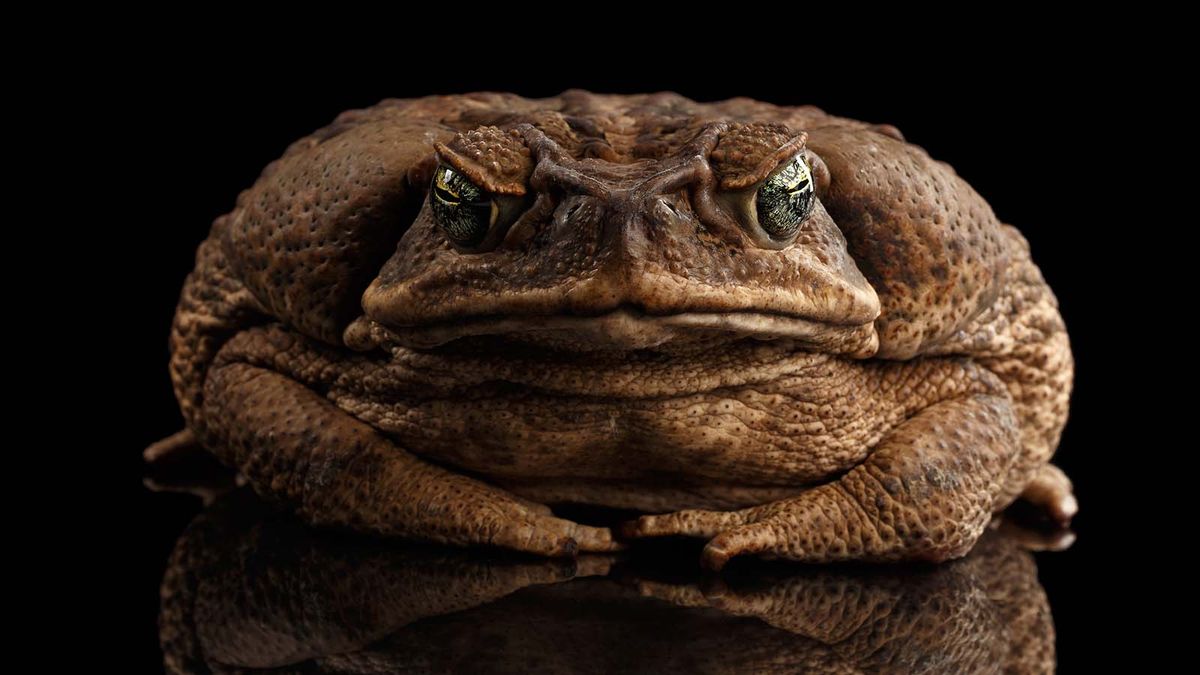
Invasive cannibalistic cane toad tadpoles in Australia eat so many of their younger hatchlings that they’ve become locked into an accelerating evolutionary arms race.
The cane toad (Rhinella marina) hatchlings, born by the thousands in small pools Down Under, have no natural predators in Australia, but they do have to contend with older cane toad tadpoles who feast on the defenseless amphibian younglings. This is causing the hatchlings to develop at a breakneck pace into tadpoles themselves, according to a new study in the Proceedings of the National Academy of Sciences of the United States of America, causing the tadpoles to in turn become even more aggressive cannibals.
Cane toads are not native to Australia, but instead South America. According to our sister site LiveScience, the cane toad was introduced to Australia in the 1930s by sugarcane farmers who believed the toad would make a great pest control solution to their beetle problem. From just 102 toads in the 1930s, the population has exploded to more than 200 million.
This is owing both to the lack of natural predators and natural proliferation, with female toads capable of laying more than 10,000 eggs in a single go. As subsequent generations are born in the same pool, the defenseless hatchling cane toads are at the mercy of the survivors of the proceeding generation, which have just developed the capacity to eat on their own and whose metabolism leads to a voracious appetite.
“When these eggs first hatch, the young can’t swim or eat yet, so they can pretty much only lie there on the bottom of the pond until they develop into tadpoles,” said Jayna DeVore, an biologist at Tetiaroa Society, a non-profit organization in French Polynesia, who specializes in invasive species and co-authored the study.
“Once the hatchlings develop into tadpoles,” DeVore explained, “they are too large and mobile for other tadpoles to eat them, so the cannibals have to work quickly if they want to consume them all.”
“These toads have gotten to the point where their own worst enemy is themselves,” DeVore told Nature.
Invasive nature of cane toads makes their evolution into frenzied cannibals easier to identify
“When I first saw this behavior in the wild, I was amazed at how voraciously cane toad tadpoles sought out cane toad hatchlings and ate them,” DeVore said.
To see how aggressive the cane toads’ cannibalistic behavior developed over time, DeVore’s team looked to the source: South American cane toads. While still the same species, the 86 years the invasive group of cane toads has spent in Australia has clearly changed them.
While some cannibalism was observed in the native South American cane toads, their Australian counterparts engaged in cannibalism 2.6 times more often over the course of 500 experiments with different individual tadpoles. The Australian tadpoles were also far more attracted to the hatchlings than their South American counterparts. When setting up a two traps, one with hatchlings and one without, Australian tadpoles were 30 times more likely to enter the hatchling trap.
“[South American] tadpoles were not attracted to the hatchlings; they were just as likely to enter the empty trap as the hatchling trap,” DeVore said. “This demonstrated that this strong attraction to the vulnerable hatchling stage, which is what helps the cannibalistic tadpoles to detect and locate their victims in Australia, is not present in the native range.”
To combat this, the hatchlings have responded by speeding up their development cycle, spending less time in their egg and hatchling stages. “We found that cane toad clutches from Australia developed more quickly; they reached the invulnerable tadpole stage in about four days, whereas native range clutches took about five days,” DeVore said.
Even more incredible, Australian hatchlings appear to have developed a sense for when a cannibalistic tadpole is threatening their clutch, accelerating their own development in response. This has come at a cost though, as this more rapid maturation in early egg and hatchling stages appears to lead to slower development in the tadpole stage.
“The good news is that cannibalism can control population growth,” DeVore said. “So, although cane toads are unlikely to drive themselves extinct, these cannibalistic behaviors may help to regulate their abundance post-invasion.”
Analysis: invasive species are no joke
Invasive species are a major problem around the world as careless humans spread different species wherever we go, usually wreaking havoc on a local ecosystem.
While the Australian cane toad is one of the most famous examples of an invasive species, it’s not the only one that Australia has had to deal with. Famously, rabbits were introduced to Australia in the 1850s and proceeded to, well, breed like rabbits, posing considerable threat to land and agriculture.
Australia isn’t alone, either. The most well-known case – the Columbian exchange, when European colonizers reached the Americas – introduced to the Americas and brought back to Europe countless species of plant, animal, and contagious pathogen which had profound and lasting effects on the ecosystems of three continents.
Fortunately, our knowledge of these interactions has improved in the last century and we’re much more conscientious about invasive species, but as the world becomes ever more interconnected, invasive species are only going to proliferate with unknowable consequences for the future.
